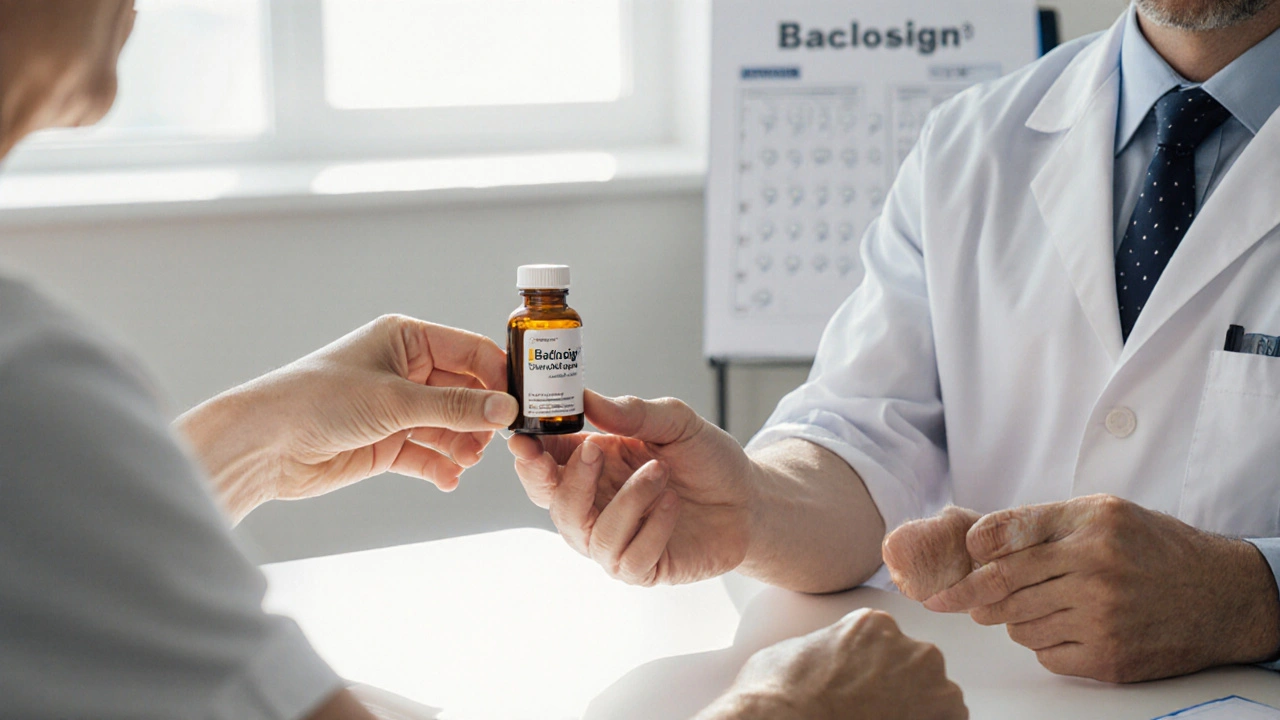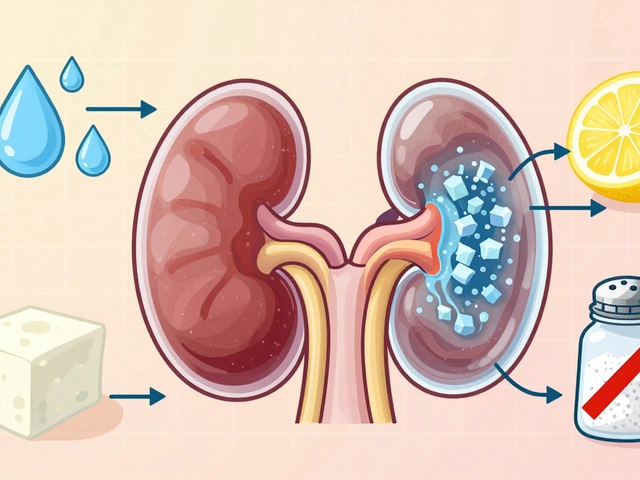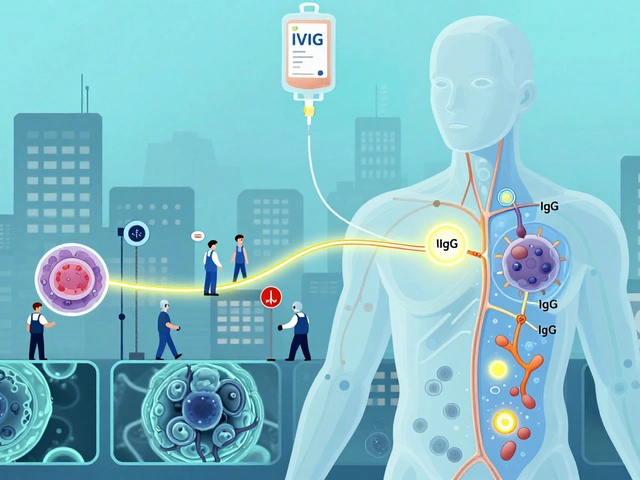Muscle Relaxant Decision Guide
Find Your Best Option
Answer a few questions about your condition and preferences to identify the most suitable muscle relaxant option.
1. What's causing your spasticity?
Multiple Sclerosis
Common with MS-related spasticity
Cerebral Palsy
Common in CP-related spasticity
Spinal Cord Injury
Common after spinal cord trauma
Other
Muscle tension from other causes
When a doctor prescribes Baclosign - the brand name for baclofen - the goal is usually to tone down painful muscle spasms. But Baclosign isn’t the only option on the market. This guide breaks down how it stacks up against the most common alternatives, so you can see which choice fits your lifestyle, budget, and health profile.
Key Takeaways
- Baclosign works by dampening nerve signals in the spinal cord, making it effective for spasticity but prone to drowsiness.
- Oral alternatives such as tizanidine and gabapentin offer different mechanisms and side‑effect profiles that may suit some patients better.
- Non‑drug options like targeted physical therapy can provide comparable relief for mild to moderate spasms without medication risks.
- Cost varies widely: Baclosign’s generic version is cheap, while brand‑name tablets and some newer drugs can be pricey in the UK.
- Choosing the right therapy hinges on factors like underlying condition, kidney function, and tolerance for sedation.
What Is Baclosign?
Baclosign is a muscle‑relaxant medication that contains the active ingredient baclofen. It was first approved in the 1970s for treating spasticity caused by multiple sclerosis, cerebral palsy, or spinal cord injury. The drug is taken orally, usually in 5‑10mg doses, and the amount is gradually increased to a typical maintenance range of 20‑80mg per day, divided into three doses.
The primary benefit of Baclosign is its ability to curb involuntary muscle contractions by acting as a gamma‑aminobutyric acid‑B (GABA‑B) receptor agonist. By enhancing GABA‑B activity, the drug reduces the release of excitatory neurotransmitters, which quiets overactive nerves.
Common side effects include drowsiness, dizziness, weakness, and occasionally nausea. Because the drug is eliminated through the kidneys, dose adjustments are recommended for patients with renal impairment.
In the UK, the generic baclofen tablet costs roughly £4-£6 for a 30‑day supply, while the branded Baclosign can be a bit more expensive, around £12‑£15 per month.
Popular Alternatives to Baclosign
Below are the most frequently considered substitutes, each with a distinct mechanism and usage pattern.
Tizanidine
Tizanidine is an α‑2 adrenergic agonist that reduces spasticity by decreasing nerve signals from the spinal cord. Typical dosing starts at 2‑4mg at bedtime, titrating up to 8mg three times daily. It’s praised for rapid onset but can cause dry mouth, low blood pressure, and liver‑enzyme elevations. Cost in the UK averages £8‑£11 per month for the generic version.
Gabapentin
Although originally designed for epilepsy, gabapentin is widely used off‑label for neuropathic pain and muscle spasms. It binds to the α2δ subunit of voltage‑gated calcium channels, dampening excitatory neurotransmission. Dosage ranges from 300mg three times daily up to 1,800mg per day. Side effects include sedation, ataxia, and edema. The drug is inexpensive, typically £5‑£7 per month.
Cyclobenzaprine
Cyclobenzaprine is a tricyclic‑derived muscle relaxant that works centrally to interrupt pain pathways. It’s usually prescribed for short‑term use (up to three weeks) at 5‑10mg three times daily. Anticholinergic effects such as dry mouth, constipation, and blurred vision are common. Pricing sits around £9‑£12 per month.
Clonazepam
Clonazepam belongs to the benzodiazepine class and offers both anxiolytic and muscle‑relaxant properties. Low doses (0.5‑2mg) at night can help with spasms linked to anxiety‑triggered tension. Risks include dependence, cognitive blunting, and withdrawal symptoms, so it’s generally a second‑line choice. Monthly cost averages £6‑£9 for the generic.
Physical Therapy
Targeted physiotherapy regimes - stretching, strengthening, and neuromuscular re‑education - address the root cause of spasticity without medication. Sessions typically cost £30‑£50 each, but many NHS trusts provide free access for qualifying patients. Results are gradual but sustainable, and there’s no pharmacologic side‑effect burden.

Side‑Effect Comparison
Understanding how each option may affect you is essential. Below is a concise side‑effect snapshot.
| Medication | Common Side Effects | Serious Risks | Typical Onset |
|---|---|---|---|
| Baclosign | Drowsiness, weakness, nausea | Seizures on abrupt withdrawal | 1‑2hours |
| Tizanidine | Dry mouth, dizziness, fatigue | Liver toxicity, severe hypotension | 30‑60minutes |
| Gabapentin | Sleepiness, edema, weight gain | Respiratory depression in high doses | 2‑3hours |
| Cyclobenzaprine | Dry mouth, constipation, blurred vision | Cardiac arrhythmia (rare) | 1‑2hours |
| Clonazepam | Drowsiness, memory impairment | Dependence, withdrawal seizures | 30‑60minutes |
| Physical Therapy | Muscle soreness, joint strain | Rare injury from improper technique | Gradual (weeks) |
Cost Comparison (UK, 2025)
Price is often a deciding factor, especially for long‑term use. Below is an average monthly cost estimate for each option.
| Option | Generic Price (£) | Brand Price (£) | Notes |
|---|---|---|---|
| Baclosign (baclofen) | 4‑6 | 12‑15 | Generic widely available |
| Tizanidine | 8‑11 | - | Requires liver‑function monitoring |
| Gabapentin | 5‑7 | - | Often prescribed for neuropathic pain |
| Cyclobenzaprine | 9‑12 | - | Short‑term use only |
| Clonazepam | 6‑9 | - | Risk of dependence |
| Physical Therapy (NHS‑provided) | 0 | 0‑120 (private) | Free for eligible patients via NHS |
How to Choose the Right Option
Deciding between Baclosign and its alternatives isn’t a one‑size‑fits‑all process. Consider the following criteria:
- Underlying cause: Spasticity from multiple sclerosis often responds well to baclofen, while tension‑type muscle pain may improve with gabapentin or physiotherapy.
- Kidney or liver health: Baclosign is cleared by the kidneys; patients with renal dysfunction need dose cuts. Tizanidine and cyclobenzaprine are metabolized by the liver, so liver disease steers you toward baclofen or gabapentin.
- Need for sedation: If you must stay alert (e.g., driving), avoid baclofen or clonazepam, which can cause pronounced drowsiness.
- Potential for dependence: Benzodiazepines like clonazepam carry a higher addiction risk. Non‑drug options remove that concern.
- Cost sensitivity: Generic baclofen and gabapentin are the cheapest. If you qualify for NHS physiotherapy, that may be the most economical long‑term solution.
Work with your prescriber to map your personal health profile against these factors. A trial of 2‑4 weeks on a low dose can reveal how you tolerate the medication before committing to a higher regimen.

Practical Tips for Safe Use
- Never stop baclofen abruptly; taper over several days to avoid withdrawal seizures.
- Take muscle‑relaxant tablets with food to reduce stomach upset.
- Schedule regular liver (for tizanidine, cyclobenzaprine) or kidney (for baclofen) blood tests as advised.
- Combine medication with a tailored exercise program for the best functional outcome.
- Keep a symptom diary - note spasm frequency, intensity, and any side effects. Share it with your clinician.
Next Steps
If you’re currently on Baclosign and experiencing unwanted sedation, talk to your doctor about switching to a lower dose, trying tizanidine, or adding physiotherapy. If you haven’t tried a muscle‑relaxant yet, ask whether a short trial of gabapentin could address both pain and spasms, especially if you also have neuropathic symptoms.
Remember, the best choice balances effectiveness, safety, and affordability. Use the comparison tables above as a quick reference, and keep the conversation open with your healthcare team.
Frequently Asked Questions
Can I take Baclosign and Tizanidine together?
Combining two central muscle‑relaxants can increase sedation and the risk of respiratory depression. Doctors usually avoid overlapping these drugs unless the dose of each is kept very low and the patient is closely monitored.
Is baclofen safe for pregnancy?
Animal studies show some fetal risk, and human data are limited. Most guidelines recommend avoiding baclofen during the first trimester unless the benefit clearly outweighs the potential harm.
How long does it take for baclofen to start working?
Oral baclofen typically begins to reduce spasticity within 1‑2hours after a dose, but noticeable improvement in daily function may require several days of consistent dosing.
Are there non‑drug options that work as well as baclofen?
Targeted physiotherapy, especially when combined with stretching and strengthening exercises, can achieve comparable relief for mild‑to‑moderate spasms. The results are slower but side‑effect free.
What should I do if I miss a dose of Baclosign?
Take the missed dose as soon as you remember, unless it’s almost time for your next scheduled dose. In that case, skip the missed one and continue with your normal schedule - never double up.







8 Comments
Mariah Dietzler
Baclofen works but the side‑effects can be a real pain.
Nicola Strand
While the guide lists several viable pharmacologic options, it neglects the ethical imperative to prioritize non‑pharmacological interventions whenever possible. In modern practice, we should first explore physiotherapy and occupational strategies before exposing patients to sedating agents. The pharmaceutical focus here betrays a profit‑driven narrative that undervalues the agency of individuals managing their own health. A more balanced approach would highlight the long‑term benefits of exercise, stretching, and functional training, which bear minimal risk and no dependence potential.
Jackie Zheng
There is a certain elegance to the way the comparison charts are laid out, making the information easily digestible. However, one should not overlook the importance of renal function when selecting baclofen, as dosage adjustments are crucial for safety. The same rigor applies to tizanidine, which demands liver monitoring. Moreover, the distinction between short‑term and chronic use is pivotal; cyclobenzaprine, for instance, is intended for brief courses only. In practice, a clinician must weigh each patient’s comorbidities against the pharmacodynamics of the drug.
Tammie Sinnott
Let’s cut to the chase: baclofen is a solid first‑line for spasticity, but it isn’t the holy grail. If you have kidney issues, you’ll need a lower dose or a different agent. Tizanidine can be a game‑changer for those who can tolerate its blood‑pressure effects, though liver labs become a routine. Gabapentin shines when neuropathic pain co‑exists with muscle tightness, offering a dual benefit. And never forget that physical therapy isn’t just a fallback-it’s a frontline, especially for mild cases. Each option has its own risk‑reward profile, so a personalized trial is the smartest move.
Michelle Wigdorovitz
Imagine sitting in a bustling market of treatments, each stall offering a different flavor of relief. Baclofen sits at the heavy‑metal corner, strong but sometimes a bit dull‑edged. Tizanidine, with its swift onset, feels like a pop‑up coffee-quick but potentially jittery. Meanwhile, gabapentin is the comforting tea, soothing nerves beyond just muscles. Physical therapy is that seasoned chef who crafts a balanced menu over time, no shortcuts needed. The key is to taste a little of each, note the after‑effects, and settle on the one that fits your lifestyle like a well‑tailored jacket.
Quinn S.
It is imperative to observe that the presented data suffers from a lack of statistical rigour. The absence of confidence intervals renders the cost comparison merely anecdotal. Moreover, the side‑effect matrix fails to distinguish between dose‑dependent and idiosyncratic reactions. Such omissions undermine the guide’s utility for evidence‑based prescribing. A clinician should demand more granular data before endorsing any of the listed regimens.
Dilip Parmanand
Start low, go slow. If you feel drowsy, cut the dose in half. Keep a simple log of spasm frequency. Talk to your doctor before any changes. Consistency beats quick fixes.
Sarah Seddon
Hey there! Let’s celebrate the fact that you have options-don’t let the fear of side‑effects freeze you out. Baclofen can be your ally when you titrate carefully, and the generic price makes it accessible. If sedation is a concern, gabapentin might give you a smoother ride without the heavy drowsy cloud. Physical therapy adds that superhero cape of functional strength, and when combined with the right med, the results can be spectacular. Remember, every body is a unique orchestra; sometimes the strings need the woodwinds, sometimes a solo. Keep experimenting safely, and you’ll discover the harmony that works for you.